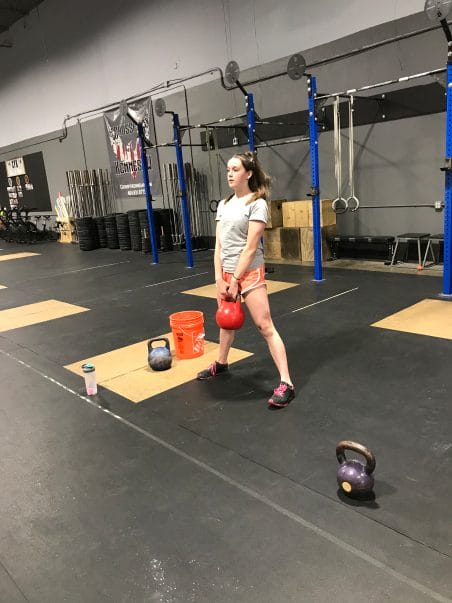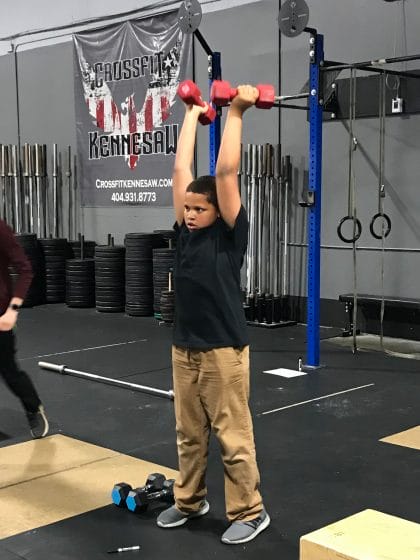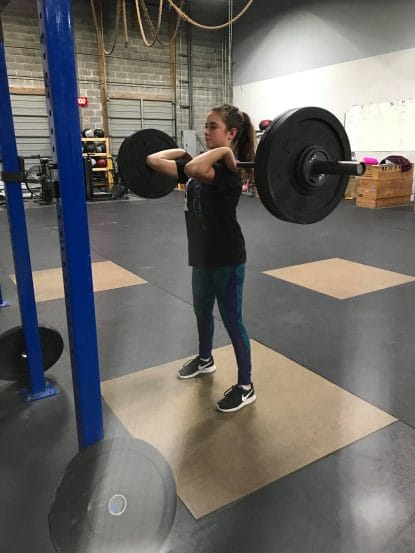By Jenn Casey, Youth Program Director
Lisa B. asks:
What is the right age for a boy to start lifting weights? Is 14 and growing a lot (seems like nightly) too early?
This is such a great question, and I hear a version of this pretty often.
The short answer: kids can (and should IMO) learn to lift! But you must find a coach or trainer who understands the unique needs of youth, and has experience working with them.
WHAT? WEIGHTLIFTING? WHO, ME?
Parents are concerned about when or if to introduce their kids to lifting weights (resistance training). I grew up in the 80s (GenX FTW!), and unless you played a sport like football, not many of us teenagers had the faintest clue about how to lift a weight, let alone the desire to.
Weights were something for those giant sportsy guys (almost never girls!). If you wanted to move and get fit, you played a sport like soccer or baseball or gymnastics, and you ran a lot. Many of us grew up with the idea that lifting weights of any kind would stunt a kid’s growth. So, lifting? Not on the radar at all when I was young!
I was 39 years old when I first touched a barbell, here at CrossFit Kennesaw. I’m not even sure I’d used a dumbbell, and had never even heard of kettlebells (which is now my primary tool for resistance training and sport). I had great instruction from day 1 here at CFK, directly from our owner and head coach Chris Shewmaker. I learned to squat, press, deadlift, clean, lunge, kettlebell swing, and I quickly grew to love lifting.

WEIGHTLIFTING, YES, ME! BUT NOW…KIDS?
When I got my first youth fitness certification just a month after my CrossFit Level 1, I was still a little nervous about how to introduce lifting to kids, and really whether or not I should. I’m a researcher, so I did a deep dive into the literature, which reassured me that the myths around weightlifting having a detrimental effect on the health of kids had pretty well been thoroughly debunked by the time I was beginning my program in 2012.
From a recent article by the American College of Sports Medicine (emphasis is mine):
With qualified supervision and a sensible progression of training loads, regular participation in youth resistance training can have a favorable influence on bone growth and development in girls and boys.
The key is to provide qualified instruction in a safe exercise environment while recognizing the physical and psychosocial uniqueness of children. In addition to prescribing the right dose (i.e., load, repetitions and sets) of resistance training, it is also important to provide meaningful feedback, foster new social networks and promote healthy behaviors. Youth who enjoy the experience of resistance training are more likely to adhere to the program and achieve training goals.
https://www.acsm.org/blog-detail/acsm-blog/2020/03/25/mythbusting-youth-resistance-training
QUALIFIED SUPERVISION: THIS IS THE KEY
When I talk to parents about lifting, in my program or somewhere else, this is the piece I emphasize the most. You HAVE to look for a coach or trainer who has worked with youth, understands their unique needs and challenges, and supports the whole child (Whole, Healthy, Youth) in their program.
All humans need to push, pull, lift, jump, etc. And kids are humans; however they are not mini adults. This doesn’t just mean “kids are smaller, so they don’t lift as heavy.” Yes, that is a true thing, but there is so much more to helping kids learn to lift than the loads.
You need a coach who understands how young humans develop physically, mentally, AND socially, at all ages and stages.
Physically, children go through many stages, and coaches who work with youth should be very knowledgable about how kids’ bodies are changing through each of these stages.

BUT WHAT ABOUT LOADS?
Before adolescence, kids aren’t able to build muscle in the ways they will be able to after puberty.
In the JV classes, we focus mainly on bodyweight movements, and learning correct positioning of feet, shoulders, and spine. Sometimes we use light dumbbells and kettlebells as a way to reinforce the movement patterns we are teaching. It can be easier to learn a Push Press when you are holding 3# or 5# dumbbells, which will challenge you to get your arms and shoulders into the correct positions.
If the JV parents express concerns about the weights their child lifts, we talk over our goals, methodology, and their worries. I remind them that what we are having them lift in class is much much lighter than their school backpack, and now they understand how to lift that much more safely!
In Varsity, we do begin to progress loads, but very slowly. As the coach, I set the upper limit on the weights for each student. Kids are always invited to drop the weight if they choose to, and must ask permission to go heavier. This is so I can ensure safety, good form, and that we are working within the best parameters for that kid during that session.
We never “max out” on loads. We do run strength cycles and I challenge them to get heavy (if they want to), but always for a multi-rep set. The most advanced Varsity students, the 17-19 year olds, will sometimes ask for and get permission to lift heavy to technical failure. These kids are heading into our adult program soon (where we also don’t “max out” very often).
GROWTH SPURTS
Kids do grow overnight, as my friend Lisa mentions in her question! Growth spurts are one of the biggest factors coaches working with youth need to be aware of, manage, and most importantly, help the kid understand and manage.
These are common signs one of my athletes (or one of my actual kids) is in or about to hit a growth spurt:
- Suddenly taller
- Suddenly heavier
- Suddenly ravenous
- Sluggish and very sleepy
- Grumpy
- Emotional
- Clumsy
- Brain fog/forgetful
- Impulse control issues
There are lots of other signs, too.
When each kid comes to class, I check in with them, ask how they’re doing, how their day was, any vacations or fun things coming up, etc. I do this because I’m interested in their lives. AND I do this to assess their mood, physicality, mental acumen. These things will be factors in what, if anything, they lift tonight.
GROWTH SPURT CHALLENGES AND CONSIDERATIONS
Kids who have suddenly grown have to re-learn how to move their longer, taller, larger bodies in space. Their range of motion changes. Their squat or deadlift stance may need to be adjusted. Their bodies might be tight, or sore, and they will need more mobility.
Plus, they’re grumpy and mentally out of it sometimes. Moving their bodies, breaking a sweat, those will help with mood, brain fog, and more serious concerns like depression and anxiety.

HOW DO WE HANDLE THEM IN CLASS?
Your kid had a growth spurt? It’s great they came to class tonight! We will adjust their stances, and lower our expectations about how far they will get into a squat. We will change up movements, and keep loads light, and joke around and have fun. We will NOT make comments about losing weight or leaning out. We will focus on good solid movement, form and technique, and enjoying movement, just like we do every night.
SOCIAL AND EMOTIONAL CONSIDERATIONS
Kids are going through a lot, physically and emotionally. My class should not be a place for them to feel unwelcome or unsafe, judged, or criticized. We coaches support them in positive, affirming ways. And we ensure that they are doing that for each other, too. We don’t allow mean teasing, body comments, comments about weights lifted/movements by other kids. The teens do like to engage in playful smack-talk, but I am on alert to ensure that everyone involved in that kind of banter is enjoying it, and I put a stop to it if things are getting a little too personal.
QUESTIONS TO ASK YOUTH FITNESS AND SPORT COACHES
If you want to ensure that your kid is working with someone who is knowledgeable about working with youth, here are some questions you should ask:
- What is your experience training or coaching kids?
- What ages have you worked with (someone with only teenager experience might not be the best person to work with 8 year olds)?
- What are your favorite ages to work with, and why?
- How do you handle growth spurts?
- How do you handle a kid who is having a bad day?
- How do you decide which loads a kid should lift that day?
- What do you do if the kid wants to lift heavier or lighter?
- What do you say to kids who engage in negative self-talk or negative talk about others in the class?
- What are the goals of your program and how do you help kids achieve them?
- What, if any, level of input/involvement do you invite from the kids themselves?
- What are your lifting/sport qualifications?
That last question is the last one for a reason. Qualifications are important; don’t get me wrong. But if the answers to the first set of questions aren’t what you’re looking for, the letters and numbers designating that coach’s qualifications do not matter.
If you have a kid who is interested in learning how to lift weights, let us know how we can help!
